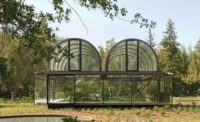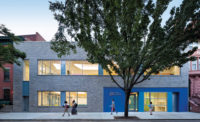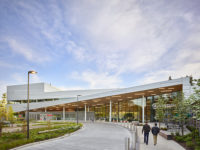When Planned Parenthood of New York City (PPNYC) set out to build its first facility in the borough of Queens, the organization commissioned New York–based Stephen Yablon Architecture to lead the design. “They were an exceptional client,” says the architect. “They recognized the importance of architecture in helping to create a positive patient experience.” The architects were challenged with designing an open, welcoming space on a tight site while meeting stringent security requirements and privacy concerns. The building, which opened in two phases, at the end of 2015 and beginning of 2016, also needed to respond sensitively to its context in a diverse, primarily residential neighborhood. Matching the scale of the adjacent brownstones if not the look, the low-slung, unabashedly modern 15,000-square-foot Diane L. Max Health Center has an assertive yet sympathetic presence on the street. Asymmetric fenestration of high-security glass and porcelain panels in the organization’s characteristic blue punctuate rows of light gray brick.
The compact facility, named for and largely funded by the current PPNYC board chair, contains counseling, exam, procedure, and recovery rooms in addition to waiting areas and offices. A second-floor community healtheducation space, which can be accessed even when the clinic is closed, has already seen significant use. “They’ve had staff training, sex-ed workshops for teens—even other nonprofits have used it,” Yablon says. “It’s been very busy.”
In configuring the interior spaces, the architects aimed to keep it simple and easy to navigate by placing exam rooms in the center and bathrooms, labs, and waiting and circulation areas on the perimenter. “We don’t want it to feel like an endless warren of corridors,” says Yablon. “This is a community where over 130 languages are spoken. How are we going to make people from so many different cultures feel welcome here?” Responding to this question, the team employed a wayfinding system based on colors and numbers. These bold graphics, coordinated with colored LED strips, provide a counterpoint to the sleek, white interiors and help convey the state-of-the-art nature of the facility’s services.









Post a comment to this article
Report Abusive Comment